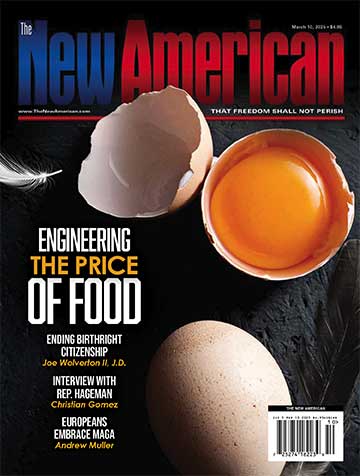
SINGAPORE — Indonesia is following in the footsteps of the BRICS group (Brazil, Russia, India, China, and South Africa) in its policy of pivoting away from the U.S. dollar in financial transactions and trade, the Southeast Asian country’s central bank stated.
The portal SINDOnews reported that Jakarta has unveiled measures to conduct transactions in local currency for cross-border trades, quoting Bank of Indonesia Governor Perry Warjiyo.
“Indonesia has initiated diversification of the use of currency in the form of LCT [local currency trading]. The direction is the same as the BRICS. In fact, Indonesia is more concrete,” Warjiyo declared last Friday at a press conference.
Indonesia has already introduced LCT with various countries, such as Thailand, Malaysia, China, and Japan, he stated, and is poised to ink a cooperation agreement with South Korea on local currency trading in early May.
Warjiyo’s revelation came as the BRICS economic bloc announced their plans to set up a joint payment network to reduce dependence on the greenback. BRICS member states have been using local currencies in mutual trade more often, and have been trying to set up a new reserve currency.
For example, in March 2023, Brazil and China signed a deal to trade in their own currencies, shifting away from the U.S. dollar as an intermediary. This bilateral deal came amid massive sanctions imposed by Western nations against Russia, a key worldwide energy producer and exporter.
Both BRICS member countries also hoped to boost cooperation on energy and minerals. Media reports disclosed that this deal would facilitate bilateral trade and financial transactions to a considerable extent, with the yuan exchanged for the Brazilian real and vice versa, while omitting the U.S. dollar. “The expectation is that this will reduce costs … promote even greater bilateral trade and facilitate investment,” AFP quoted the Brazilian Trade and Investment Promotion Agency as saying.
The two countries also purportedly declared the establishment of a clearinghouse to enable lending in national currencies, decreasing transaction costs between both ends, and to conduct settlements without the dollar. China has been Brazil’s largest trading partner for over a decade, with bilateral trade achieving a historic $150 billion last year.
The People’s Bank of China (PBOC) said that such arrangements would bolster the use of the yuan for cross-border transactions between enterprises and financial institutions, increasing bilateral trade and investment, and Secretary for International Affairs at the Ministry of Finance of Brazil Tatiana Rosito posited that 25 countries were already facilitating settlements with China in yuan.
In addition to China’s efforts to abandon the dollar in international trade, India has implemented various steps toward using Russian rubles and Indian rupees in bilateral trade with Moscow.
Since Western nations unleashed the first batch of sanctions against Russia in 2014 over Russian actions in Crimea, Moscow has been de-dollarizing the country’s economy, further relying on alternative currencies in transactions since 2022.
Russian President Vladimir Putin even proposed that the Chinese yuan should be used on a more widespread basis in Russia’s trade with China, Africa, and Latin America. Recent data from the Bank of Russia divulged that the yuan has become a crucial element in Russia’s foreign trade.
Governor Mikhail Degtyarev of Russia’s Khabarovsk region recently asserted that Ukraine-linked Western sanctions against his country have not halted investment flows in the region. The official claimed that his area saw a total of 26 new investment projects worth 133 billion rubles ($1.6 billion) in 2022, including a massive infrastructure project to construct the Pacific Railroad. “It is comparable to the historical construction of the BAM (Baikal–Amur Mainline railway). It is the first private railroad in Russia to have a length of 500 kilometers. In a short period of time, we have already built 100 kilometers,” he proclaimed.
A mining and processing plant at the Kutyn gold deposit in the Tuguro-Chumikansky district and the Solnechnaya tin-ore processing station were two examples of local projects launched last year, and the development of a copper and tin producing plant in the Solnechny district is almost completed.
Degtyarev pointed out that the region in 2022 had effectively unleashed a simplified procedure for granting land to businesses without the need to bid for import substitution projects, especially in agriculture, therefore attracting investors. Individual entrepreneurs and legal entities involved in import substitution also enjoyed the benefits of the procedure, being able to purchase a land plot for the token sum of a ruble.
Degtyarev highlighted that Khabarovsk has been assiduously boosting collaboration with China in the past couple of months, with bilateral trade between the region and Beijing up 31 percent, and cargo turnover up by 106 percent year-on-year as of the end of last year.
The region is also continuing efforts to develop the Russo-Chinese joint trans-border development territory on Bolshoi Ussuriysky Island, where both Russian and Chinese firms can be residents and obtain key benefits for export-import operations, rendering the area a de facto free-trade zone.
“We are seeing a turn to the East. There is growth in cargo turnover, growth in industrial production as a whole, and growth in the gross regional product. The Eastern part of the country is now pulling the economy, because the Western regions, unfortunately, faced treacherous sanctions and the collapse of logistics chains,” the official commented.
Russia is turning to national currencies in energy trade with foreign partners, Deputy Prime Minister Alexander Novak said over the weekend in an interview with Russia-1. He added that most transactions are in these currencies, primarily in Chinese yuan and Russian rubles, with Moscow hoping to ditch the euro and the greenback completely in energy exports.
“The trends have changed greatly toward reducing the use of dollars and euros. Considering the current problems with these currencies, in our settlements we are switching almost exclusively to national currencies,” Novak said, alluding to Western-led sanctions that have deprived Russia of the ability to conduct transactions in euros and dollars. “Our partners in China are already paying for gas in yuan, as well as partly for oil. They also pay in rubles. We will continue to improve these mutual settlements in national currencies.”
The deputy premier added that settlement mechanisms are necessary, “which can only be in national currencies under the current circumstances,” to meet strong demand for Russian energy.
In an interview with the TASS news outlet, Novak forecast that the proportion of transactions in national currencies will increase in the near future. Russia remarkably escalated its use of national currencies in trade last year, calling the euro and dollar “unreliable” owing to the sanctions.




